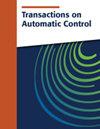基于方位的编队控制通用框架
IF 7
1区 计算机科学
Q1 AUTOMATION & CONTROL SYSTEMS
引用次数: 0
摘要
近十年来,基于方位的地层控制一直是研究的热点。然而,现有的研究结果主要集中在单积分器或双积分器系统上,并假设所有的前导体都以恒定的速度运动。在本文中,我们的目标是建立一个通用的框架来处理基于方位的编队控制。该框架提供了三个特性。首先,我们的问题是针对一般的异构多智能体线性系统制定的,其中包括作为特例的高阶积分系统。其次,领导者的理想位置是由一些称为外系统的线性自治系统产生的。这样的系统可以产生大量的信号,如具有未知系数的任意程度的多项式或任意振幅和初始相位的三角多项式。因此,不同的领导者可以有不同的时变速度。第三,目标形成可以在存在大量干扰的情况下实现。我们的方法的一个关键技术是所谓的基于方位的分布式外系统观测器。基于方位的分布式观测器,结合经典的输出调节理论,给出了一种统一的方法来处理一般线性系统和大型编队机动的基于方位的编队。本文章由计算机程序翻译,如有差异,请以英文原文为准。
A General Framework for the Bearing-Based Formation Control
The bearing-based formation control has been an active research topic over the past decade. However, the existing results mainly focus on single- or double-integrator systems and assume that all the leaders move with a constant velocity. In this article, we aim to establish a general framework to handle the bearing-based formation control. The framework offers three features. First, our problem is formulated for general heterogeneous multiagent linear systems, which include high-order integrator systems as a special case. Second, the desired positions of the leaders are generated by some linear autonomous systems called exosystems. Such systems can generate a large class of signals such as polynomials of any degree with unknown coefficients or trigonometric polynomials of arbitrary amplitudes and initial phases. Hence, different leaders can have different time-varying velocities. Third, the target formation can be achieved in the presence of a large class of disturbances. A key technology of our approach is the so-called bearing-based distributed observer for an exosystem. The bearing-based distributed observer, in conjunction with the classical output regulation theory, leads to a unified approach to handling the bearing-based formation for general linear systems and for a large class of formation maneuvers.
求助全文
通过发布文献求助,成功后即可免费获取论文全文。
去求助
来源期刊

IEEE Transactions on Automatic Control
工程技术-工程:电子与电气
CiteScore
11.30
自引率
5.90%
发文量
824
审稿时长
9 months
期刊介绍:
In the IEEE Transactions on Automatic Control, the IEEE Control Systems Society publishes high-quality papers on the theory, design, and applications of control engineering. Two types of contributions are regularly considered:
1) Papers: Presentation of significant research, development, or application of control concepts.
2) Technical Notes and Correspondence: Brief technical notes, comments on published areas or established control topics, corrections to papers and notes published in the Transactions.
In addition, special papers (tutorials, surveys, and perspectives on the theory and applications of control systems topics) are solicited.
 求助内容:
求助内容: 应助结果提醒方式:
应助结果提醒方式:


